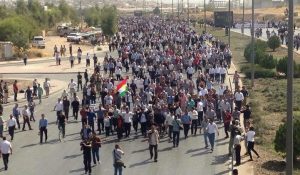Author: Ravi
Watching Football from a Cage
Today, for the first time in my life, I stepped into a stadium to watch a football match.
Not because I had never been a fan of football, but because, for decades, Iranian women were banned from entering stadiums—barred from the joy of watching a simple game, stripped of the right to cheer for their favorite teams.
For years, women who longed to experience this atmosphere had no choice but to disguise themselves—cutting their hair, wearing men’s clothes, and pretending to be someone they were not, just to step through those gates.
One of these women was Sahar Khodayari.
She dreamed of standing in a stadium, surrounded by roaring fans, chanting for her team.
But instead, she was arrested.
They insulted her, they beat her—and in the end, she set herself on fire.
She had worn blue that day, the colors of her beloved team.
The world came to know her as The Blue Girl.
A week later, she died from her burns in a hospital bed.
The Islamic Republic dismissed her death, branding her as mentally ill—denying that she was a protester, denying that she was simply a football fan who had wanted nothing more than to cheer.
And today, as I walked through streets lined with riot police and special forces, making my way toward the stadium, I whispered to myself:
“I am living her final wish—an incomplete, distorted version of what she once dreamed of, a dream that cost her life.”
When The Blue Girl died, no uprising followed.
Days turned into weeks, and the repression continued.
But under mounting pressure from activists and journalists, FIFA was forced to act—threatening to expel Iran from international football if women were not allowed into stadiums.
Backed into a corner, the government finally relented.
But they did not open the doors to everyone.
The first women allowed in were handpicked—officials’ relatives, government employees, a few carefully selected celebrities.
Ordinary women, the ones who had fought for this right, were still locked out.
No public ticket sales. No real victory.
Once again, outcry followed, and once again, the government was forced to make concessions—letting in more women, but always on their terms, in tightly controlled numbers.
And so here I am today, watching a simple football match, knowing that even this small moment of joy was wrung from years of resistance.
But before we celebrate, we must ask:
Why were women banned in the first place?
The Islamic Republic’s defenders and supporters offer many justifications, but at their core, they all stem from one belief:
That a woman’s presence is un-Islamic.
As a theocracy, the regime claims that Iran belongs to Muslims and that its laws must be shaped around religious doctrine, preparing for the arrival of the prophesied savior.
But Iran is not a monolithic Islamic society.
Like every other country, it is home to people of diverse beliefs.
And like so many times before, those who do not fit the regime’s vision—those who think differently, live differently—are silenced, ignored, erased.
Why, in the Islamic Republic’s eyes, is a woman’s presence in a stadium forbidden?
Because, they argue, if a woman stands in a crowd—if she cheers, if she jumps with joy, if her hair is visible, if her body exists—men might be aroused.
And that, they say, leads to sin.
So women must be hidden. Must be covered. Must not take up space.
And if a woman dares to celebrate, to sing, to raise her voice—she is a danger, an offense, a temptation that must be kept out.
My Experience
From midday, the sound of honking horns filled the air.
In this small city, people were electric with excitement, ready to cheer for their team.
I, too, felt a restless thrill.
An hour before the match, we reached the stadium.
Every street leading to it was blocked by police and special forces.
The atmosphere was suffocating.
The officers laughed together, posing for photos as if they were victorious warriors.
The people, in contrast, looked at them with a mix of fear and fury.
Nearby, a woman turned to another, pressing a ticket into her hand.
“I forgot my scarf,” she murmured, her voice tight with frustration. “And my glasses. They won’t let me in like this. You take it—watch it for me.”
However, a significant number of young women had left their hair uncovered, merely draping a scarf around their necks.
We all lined up, waiting in the queue for a few minutes before entering the stadium. It was there that I met some new and wonderful friends.
One of them was a delightful girl with curly hair, who, like many others, had chosen not to cover her hair.
At the entrance, we were forced to put on scarves. The officers, all of whom were women, searched our clothes and bags with unnecessary aggression.
It was an unpleasant experience, but I tried to convince myself that they were simply ensuring security—perhaps looking for explosives or weapons. I didn’t let it bother me too much, and we stepped inside.
The seating arrangement was thought-provoking. In front of us stood an extremely tall barrier, making it difficult to watch the game from the women’s section. Meanwhile, the men’s section was elevated and free of such obstructions.
As soon as I sat down, I noticed four surveillance cameras zoomed in directly on the female spectators. Even more striking was the presence of dozens of female police officers, dressed in black chadors and wearing masks, standing right in front of us.
They were not there to maintain order. In reality, they had no concern for the seating arrangements, the game, or the safety of the spectators. Their sole purpose was surveillance and suppression.
They were armed, and in addition to the cameras mounted on their uniforms, they held handheld cameras and smartphones, recording and photographing our faces—especially those of women without hijabs, those whose hair was left uncovered, or simply those who cheered, laughed, and shouted in excitement. Even those who wished to take a closer picture of the field were targeted.
My new friend, unbothered, smiled at the stern and hostile officer filming her, undeterred by the looming threat of punishment. From behind the bars, she watched the game as much as she could.
I told myself: if we fear them, they must fear us even more.
The bars blocked my view of the game. They did not allow me to remain optimistic or to tolerate what was happening.
I thought: I must tell the world that in order for Iranian football to keep its place on the global stage, we have been caged.
So, I began taking pictures—of the conditions, of the officers.
Their crackdown wasn’t limited to young women. They were just as harsh with elderly women—women who had supported their teams for years, who had come here to celebrate, to cheer. I captured that, too.
As much as I could, I took photos.
They recorded our faces, and I recorded theirs.
For long moments, I stared directly at them—the police, the enforcers.
Our enemy wasn’t the opposing team.
They were just young men playing football.
The real enemy stood before the stands, armed. And we had to keep our eyes on the real enemy.
After taking a few more photos, I decided, for security reasons, to delete them from my phone. I stood up and headed toward the restroom, hoping to do so safely.
A female officer shouted, “Don’t let her leave!”
We were truly trapped.
She assumed I was trying to escape because of my uncovered hair. I reassured her that I was only going to the restroom and would return.
Still, I suspected that some form of punishment awaited us at the exit—perhaps a fine.
They couldn’t arrest so many women at once. A monetary penalty seemed the most practical course of action.
When I returned to my seat after erasing the photos, I asked myself:
Beyond documenting the pain and struggle of women, what else should I write in this report?
What should I demand?
Should I ask FIFA not to believe the lies of the Islamic Republic? To ban Iranian football, to sanction its teams?
At that moment, one of the players approached the women’s section. Through the bars, he respectfully greeted the crowd before embracing and kissing his mother.
She was a simple, kind-looking woman, likely from a rural background. Her joy at her son’s success was overwhelming.
Tears streamed down her face as she spoke of raising him on the bread she earned from farming.
I thought of Amir and Baran—my young students, who play football with immense effort and hope, despite hardship and poverty.
I could not, and still cannot, ask FIFA or anyone else to punish these people for the crimes of the Islamic Republic.
We have already suffered enough for things we had no part in.
Instead, I ask you—as people capable of understanding the pain and joy of others, as individuals with dreams, ambitions, and lives of your own—to stand with us in our fight for an equal and humane existence.
Hold the Islamic Republic radically and fundamentally accountable.
Work toward its downfall.
Raise awareness of what is happening in Iran.
Increase the cost of repression for the regime—make it harder for them to silence political and social activists, to crush the people.
…
As the match ended, a massive crowd surged toward the stadium’s exit gates.
The officers blocked the women from leaving, taking even more photos.
“You may leave,” they said, “but we have your pictures. You will be prosecuted.”
Prosecuted for dancing after a goal.
Prosecuted for laughing too loudly, for cheering.
Prosecuted for being a woman, for having hair, for watching football.
Here, these can be serious crimes.
The crowd shouted: “We will leave together! You are shameless!”
They were right.
Together, we walked out.
Without paying a fine.
We had imposed our will.
And now, free, I write this report for you.
I only hope that if this report leads to my arrest once again, at the very least, it will have carried an important story to the ears of others—connecting them to this fight, to this human struggle, in this corner of the world.
آدرس و اسامی صفحات مرتبط با فدراسیون عصر آنارشیسم
Federation of Anarchism Era Social Media Pages
۱- آدرس تماس با ما
asranarshism@protonmail.com
info@asranarshism.com
۲- عصر آنارشیسم در اینستاگرام
۳- عصر آنارشیسم در تلگرام
۴- عصر آنارشیسم در توئیتر
۵ – فیسبوک عصر آنارشیسم
۶ – فیسبوک بلوک سیاه ایران
۷ – فیسبوک آنارشیستهای همراه روژاوا و باکور - Anarchists in solidarity with the Rojava
۸ – فیسبوک دفاع از زندانیان و اعدامیان غیر سیاسی
۹ – فیسبوک کارگران آنارشیست ایران
۱۰- فیسبوک کتابخانه آنارشیستی
۱۱ – فیسبوک آنارشیستهای همراه بلوچستان
۱۲ – فیسبوک هنرمندان آنارشیست
۱۳ – فیسبوک دانشجویان آنارشیست
۱۴ – فیسبوک شاهین شهر پلیتیک
۱۵ – فیسبوک آنتی فاشیست
۱۶- تلگرام آنارشیستهای اصفهان و شاهین شهر
۱۷ – اینستاگرام آنارشیستهای اصفهان و شاهین شهر
۱۸- تلگرام آنارشیستهای شیراز
۱۹ – تلگرام ” جوانان آنارشیست ”
۲۰ - تلگرام آنارشیستهای تهران
۲۱ – اینستاگرام جوانان آنارشیست
۲۲ – گروه تلگرام اتحادیه آنارشیستهای افغانستان و ایران
۲۳ – توییتر اتحادیه آنارشیستهای افغانستان و ایران - The Anarchists Union of Afghanistan and Iran
۲۴ – فیسبوک اتحادیه آنارشیستهای افغانستان و ایران
۲۵ – اینستاگرام اتحادیه آنارشیستهای افغانستان و ایران
۲۶ – کانال تلگرام خودسازماندهی مطالب گروه اتحاديه آنارشیستهای افغانستان و ايران
۲۷ – گروه تلگرام خودساماندهی مطالب گروه اتحادیه آنارشیستهای افغانستان و ایران
۲۸– اینستاگرام آنارشیستهای بوکان - ئانارکیستە کانی بۆکان
۲۹- کانال تلگرام کتابخانه شورشی
۳۰- کانال تلگرام ریتم آنارشی
۳۱- تلگرام آنارشیستهای اراک
۳۲- تلگرام قیام مردمی
۳۳- ماستودون عصرآنارشیسم
۳۴- فیسبوک آنارشیستهای مزار شریف
۳۵- فیسبوک آنارشیستهای کابل









